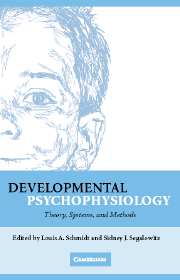Book contents
- Frontmatter
- Contents
- Foreword by Stephen W. Porges
- Preface
- Acknowledgments
- Contributors
- 1 Capturing the Dynamic Endophenotype: A Developmental Psychophysiological Manifesto
- SECTION ONE CENTRAL SYSTEM: THEORY, METHODS, AND MEASURES
- SECTION TWO AUTONOMIC AND PERIPHERAL SYSTEMS: THEORY, METHODS, AND MEASURES
- SECTION THREE NEUROENDOCRINE SYSTEM: THEORY, METHODS, AND MEASURES
- 11 Emotion, Temperament, Vulnerability, and Development: Evidence from Nonhuman Primate Models
- 12 Neuroendocrine Measures in Developmental Research
- SECTION FOUR DATA ACQUISITION, REDUCTION, ANALYSIS, AND INTERPRETATION: CONSIDERATIONS AND CAVEATS
- Index
- References
12 - Neuroendocrine Measures in Developmental Research
from SECTION THREE - NEUROENDOCRINE SYSTEM: THEORY, METHODS, AND MEASURES
Published online by Cambridge University Press: 27 July 2009
- Frontmatter
- Contents
- Foreword by Stephen W. Porges
- Preface
- Acknowledgments
- Contributors
- 1 Capturing the Dynamic Endophenotype: A Developmental Psychophysiological Manifesto
- SECTION ONE CENTRAL SYSTEM: THEORY, METHODS, AND MEASURES
- SECTION TWO AUTONOMIC AND PERIPHERAL SYSTEMS: THEORY, METHODS, AND MEASURES
- SECTION THREE NEUROENDOCRINE SYSTEM: THEORY, METHODS, AND MEASURES
- 11 Emotion, Temperament, Vulnerability, and Development: Evidence from Nonhuman Primate Models
- 12 Neuroendocrine Measures in Developmental Research
- SECTION FOUR DATA ACQUISITION, REDUCTION, ANALYSIS, AND INTERPRETATION: CONSIDERATIONS AND CAVEATS
- Index
- References
Summary
INTRODUCTION
Maladaptive responses to stress are components of both the etiology and expression of many psychiatric disorders (Anisman & Zacharko, 1982; Walker, Walder, & Reynolds, 2001). In addition, the neurobiological systems involved in activating and regulating stress-sensitive physiological systems are believed to contribute to individual differences in emotionality or temperament (Kagan, Reznick, & Snidman, 1988; Rothbart, Derryberry, & Posner, 1994). Finally, social regulation of stress physiology during development is hypothesized, based on animal studies, to regulate the expression of genes involved in the development of the neural substrates of stress and emotion (Meaney, 2001). This process, in turn, is expected to contribute to vulnerability stressors and thus to mental and physical health over the individual's life course (Sanchez, Ladd, & Plotsky, 2001). For all of these reasons, developmental researchers are interested in assessing the reactivity and regulation of stress biology in studies of children and adolescents.
Much of the focus of this work has been on the limbic-hypothalamic-pituitary-adrenocortical (LHPA) system, often considered one of the two major arms of the mammalian stress system. The LHPA system produces steroid hormones termed glucocorticoids (GCs). The predominant GC in humans is cortisol. The development of competitive binding assays in the 1960s allowed measurement of cortisol in urine and blood (Murphy, 1967). Soon afterwards, the first studies of cortisol in children appeared (e.g., Anders et al., 1970). However, the immense challenge of collecting urine reliably and the invasiveness of plasma sampling limited human developmental LHPA research (reviewed in Gunnar, 1986).
- Type
- Chapter
- Information
- Developmental PsychophysiologyTheory, Systems, and Methods, pp. 343 - 364Publisher: Cambridge University PressPrint publication year: 2007
References
- 18
- Cited by



